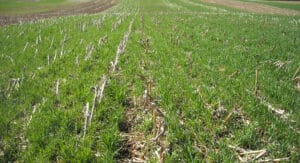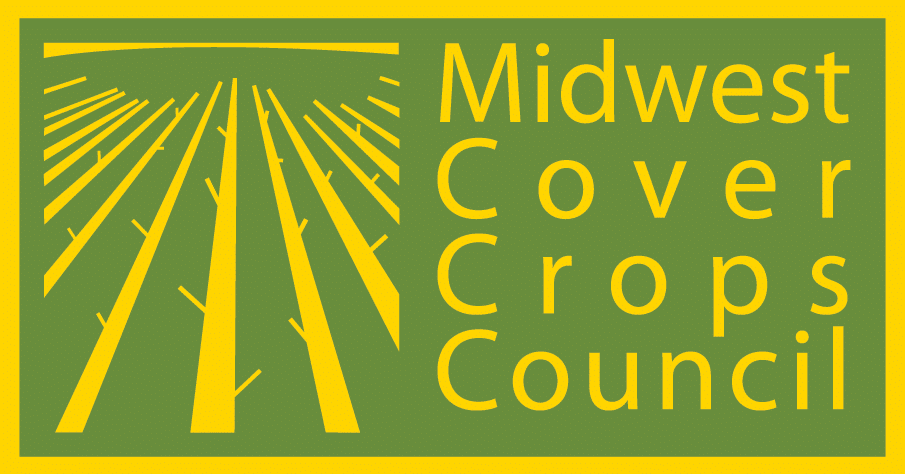Midwest Cover Crops Council (MCCC-112)
University of Missouri Extension (MX81)
This publication is intended to provide a starting point for farmers who are new to growing cover crops. With experience, farmers may fine-tune the use of cover crops for their systems.
Introduction
The following recipe provides an introductory approach to integrating a cover crop into a corn-soybean rotation. Planting a cover crop ahead of a soybean cash crop is often the easiest way to introduce cover crops into your rotation. Cereal rye has been proven to be a successful choice prior to soybean because typical fall conditions in Missouri allow for a September corn harvest, providing a suitable planting window for cereal rye.
Planning and Preparation
- Planning—Educate yourself. Start small. Be timely. Prioritize management based on your purpose and objectives.
- Corn hybrid and planting—If possible, plant the preceding corn crop early using your earliest maturity corn hybrid. One strategy is to use cover crops on the field you usually harvest first, on sloping ground, or on a field where you can watch it regularly, and to plant your earliest maturity hybrid on that field.
- Residual corn herbicides—Cereal rye can be seeded and a successful stand will occur in the fall following most of the spring-applied residuals used in corn. Publications are available to provide guidance on cover crop sensitivity to selected herbicides (see Resources section). If cereal rye will be grazed or fed to livestock, there are some restrictions. Consult herbicide labels for guidance.
- Seed purchase—Order cereal rye seed early. Named varieties can produce substantially more growth or more predictable growth and maturity, and are generally recommended. If using VNS (variety not stated) seed, be sure that it has a good germination rate (85% or higher) and is purchased from a reputable seed dealer. Note that this means the seed has been cleaned, tested for germination, and has a seed tag even though it is VNS. Bin-run seed can have lower germination, excessive foreign matter affecting planting equipment operation, and weed seed.
Fall Work
- Corn harvest—Harvest fields where cereal rye is to be planted as early as possible. September weather conditions in Missouri are conducive to on-farm, in-bin drying, allowing for higher-moisture grain to be harvested.
- Tillage or no-tillage—To allow for adequate cover crop growth, it is best or easier if no tillage is planned for after rye planting or before intended rye termination date. (The slight exception would be tilling strips for a strip-till system.) Cover crops work well with a no-till or strip-till system.
- Timing of planting—Ideally, plant cereal rye as soon after corn harvest as possible. For Missouri, plant rye no later than early November in the northern half of the state and by mid-November in the southern half of the state. Earlier planting is better, including at any time in September or October, or even by overseeding into corn before harvest. Use the Cover Crop Selector Tool (in Resources section) for more precise dates for your county.
- Seeding rate—Drilled: 50–60 lbs./acre. Broadcast with shallow incorporation: 60–70 lbs./acre. If planting in September with conducive weather conditions, broadcasting with no incorporation can be successful at the 60–70 lbs./acre seeding rate. If cereal rye is being used for grazing or if maximum erosion control is the goal, consider boosting the seeding rate by about 20% more than these recommendations. These rates are based on high-quality seed with germination rates of 85% or higher.
- Planting method—Drill to 0.75–1.50 inches deep or broadcast with shallow incorporation. An air-seeder mounted on a vertical tillage tool can also be used. Multiple planting methods can be used, including soybean split-row planters on 15 in. spacing while reducing seeding rates to 25–30 lbs./acre. At these lower rates and wider row spacing, be aware that erosion control will be less. For the highest chance of success in establishing the cover crop, direct-seeding is preferred over broadcasting seed with no incorporation.
- Fertility or liming—If applying P, K, or lime, complete the application prior to the seeding operation or apply to the growing rye before the ground freezes. If it is necessary to inject manure, low-disturbance injectors are available that will cause minimal damage to the cereal rye. Surface application of liquid manure on top of the rye is not recommended. Surface broadcast of dry manure or litter should be done prior to seeding, but 4 tons or less can be applied to growing cereal rye with minimal damage by using modern spreading equipment that provides even distribution.
Spring Work
- Scouting—In the spring, scout your cereal rye cover crop to determine how well it is growing and its coverage. But if rainfall is below normal, scout also to monitor soil moisture in case earlier termination is needed.
- Termination timing—Terminate the cereal rye in the spring when plants are 6 to 12 inches tall and actively growing or about two weeks before planting soybean—whichever comes first. Many growers will successfully plant soybean into terminated cereal rye much taller than 12 inches, especially if weed control is a primary purpose, but new cover crop users should terminate when the cereal rye is smaller (see Figure 1). As a producer gains experience, termination may not happen until planting.

height (shown here). (Eileen Kladivko)
- Termination herbicide—Cereal rye can easily be terminated with a full rate of glyphosate (minimum of 1 lb. acid equivalent per acre) after dormancy breaks in the spring. Effectiveness and rapidity of termination improves if rye is rapidly growing and air temperatures are warmer. Larger rye, rye past the boot stage, or rye sprayed during cooler weather (below 55ºF) can be more difficult to kill or will die more slowly.
- Termination modifications for dry weather—Watch the weather and be ready to modify your termination plans. In a dry spring, the cereal rye cover crop has the potential to use moisture that the cash crop will need, so terminate cover crops sooner to allow rainfall to make up the deficit by returning the soil moisture to field capacity.
- Termination modifications for wet weather—In a wet spring, when it has been very difficult to get into the fields to spray, be ready to take advantage of any break in the weather and/or use low axle weight sprayers or one with floater tires. If projected soybean planting is less than 10 days away and the rye is tall, then it often works better to spray within a day or two of planting. It is usually better to plant either into brown, completely dead rye plants that were terminated early or into standing green rye plants that will be terminated shortly after bean planting. Avoid planting beans into large, dying, yellow/green (“rubbery”) cereal rye plants that have fallen on the soil surface and formed a mat; this situation is most likely to happen when rye is terminated in the window of one to two weeks before bean planting, especially in cool weather. The terminated cereal rye will limit soil drying due to no plant growth and limited sun and wind exposure.
- Soybean planting—It is usually best to use a no-till planting approach for seeding soybean in a rye cover crop. Almost all modern planters and drills are fully capable of planting soybean into a cereal rye cover crop. Check planting depth and seed furrow closure shortly after beginning to plant into the cover crop residue as usually some adjustments are needed. Planter unit components that can affect planting performance include coulters and residue cleaners (if used), condition of disk openers, and style of closing wheels. Seed slot closure conditions may affect residual herbicide products that can be used immediately after planting. Consult herbicide labels before use.
- Scouting—After soybean planting, scout for soybean emergence and population. Population issues can be related to planter performance, voles, and slugs. Additionally, scout for weeds since substantial cereal rye residue can often delay emergence of annual weeds, which may delay the application of post-emergence herbicides.
Resources
Cover Crop Selector Tool — available from the Midwest Cover Crops Council
Cover Crops in Missouri: Putting Them to Work on Your Farm (University of Missouri Extension Guide G4161)
Evaluation of Herbicide Programs for the Termination of Cover Crop Species in the Spring, Division of Plant Sciences, University of Missouri
The Effects of Herbicide Carryover on Cover Crops, Division of Plant Sciences, University of Missouri
Authors
Charles Ellis and Rob Myers, University of Missouri (Note: This publication was adapted with consent from MCCC under a joint project to produce customized introductory guidance about cover crops for all member states/provinces.)
Reviewers and Contributors
Kerry Clark, University of Missouri; Eileen Kladivko, Purdue University; Greg Luce, University of Missouri; and Anna Morrow, Midwest Cover Crops Council; and Tim Reinbott, University of Missouri
The Midwest Cover Crops Council (www.https://www.midwestcovercrops.org) aims to facilitate widespread adoption of cover crops throughout the Midwest by providing educational/outreach resources and programs, conducting new research, and communicating about cover crops to the public.
Funding for this project was provided by McKnight Foundation.
August 2019
The U.S. Department of Agriculture (USDA) prohibits discrimination in all its programs and activities on the basis of race, color, national origin, age, disability, and where applicable, sex, marital status, familial status, parental status, religion, sexual orientation, genetic information, political beliefs, reprisal, or because all or a part of an individual’s income is derived from any public assistance program. (Not all prohibited bases apply to all programs.) Persons with disabilities who require alternative means for communication of program information (Braille, large print, audiotape, etc.) should contact USDA’s TARGET Center at (202) 720-2600 (voice and TDD). To file a complaint of discrimination write to USDA, Director, Office of Civil Rights, 1400 Independence Avenue, S.W., Washington, D.C. 20250-9410 or call (800) 795-3272 (voice) or (202) 720-6382 (TDD). USDA is an equal opportunity provider and employer. ©2019 by MCCC. All rights reserved.
